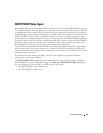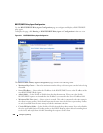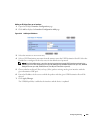
500 Configuring Routing
The BOOTP/DHCP Status page displays the following fields:
•
Maximum Hop Count
— The maximum number of Hops a client request can go without being
discarded.
•
Server IP Address
— The IP address of the BOOTP/DHCP server or the IP address of the next
BOOTP/DHCP Relay Agent.
•
Admin Mode
— The administrative mode of the relay. When you select Enable on the configuration
page, BOOTP/DHCP requests are forwarded to the IP address you entered in the Server IP address
field.
•
Minimum Wait Time (secs)
— The Minimum time in seconds. This value is compared to the time
stamp in the client's request packets, which should represent the time since the client was powered up.
Packets are only forwarded when the time stamp exceeds the minimum wait time.
•
Circuit ID Option Mode
— This is the Relay agent option, which can be either Enabled or Disabled.
If you select Enable, the relay agent adds Option 82 header packets to the DHCP Request packets
before forwarding them to the server, and strips them off while forwarding the responses to the client.
•
Requests Received
— The total number of BOOTP/DHCP requests received from all clients since the
last time the switch was reset.
•
Requests Relayed
— The total number of BOOTP/DHCP requests forwarded to the server since the
last time the switch was reset.
•
Packets Discarded
— The total number of BOOTP/DHCP packets discarded by this Relay Agent since
the last time the switch was reset.
Displaying BOOTP/DHCP using the CLI Command
For information about the CLI command that performs this function, see the following chapter in the
CLI Reference Guide:
• DHCP and BOOTP Relay Commands
IP Helper
The IP Helper feature allows the switch to forward certain configured UDP broadcast packets to a
particular IP address. This allows various applications, such as the DHCP relay agent, to reach servers on
non-local subnets, even if the application was designed to assume a server is always on a local subnet and
uses broadcast packets (with either the limited broadcast address 255.255.255.255, or a network directed
broadcast address) to reach the server.
You can configure relay entries both globally and on specific routing interfaces. Each relay entry maps an
ingress interface and destination UDP port number to a single IPv4 address (the helper address). You can
configure multiple relay entries for the same interface and UDP port, in which case the relay agent relays
matching packets to each server address. Interface configuration takes priority over global configuration.
In other words, if the destination UDP port of a packet matches any entry on the ingress interface, the
packet is handled according to the interface configuration. If the packet does not match any entry on the
ingress interface, the packet is handled according to the global IP helper configuration.


















